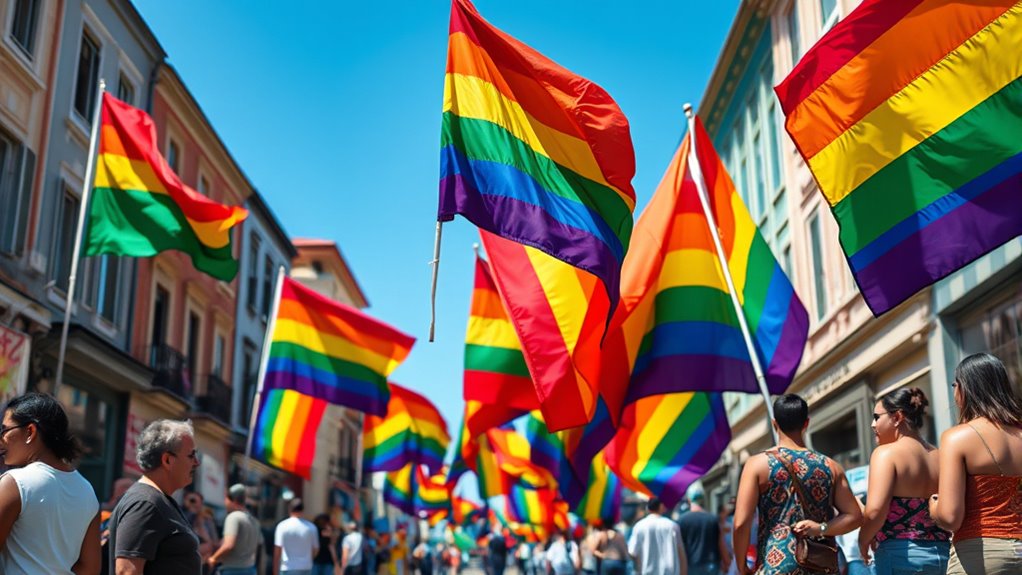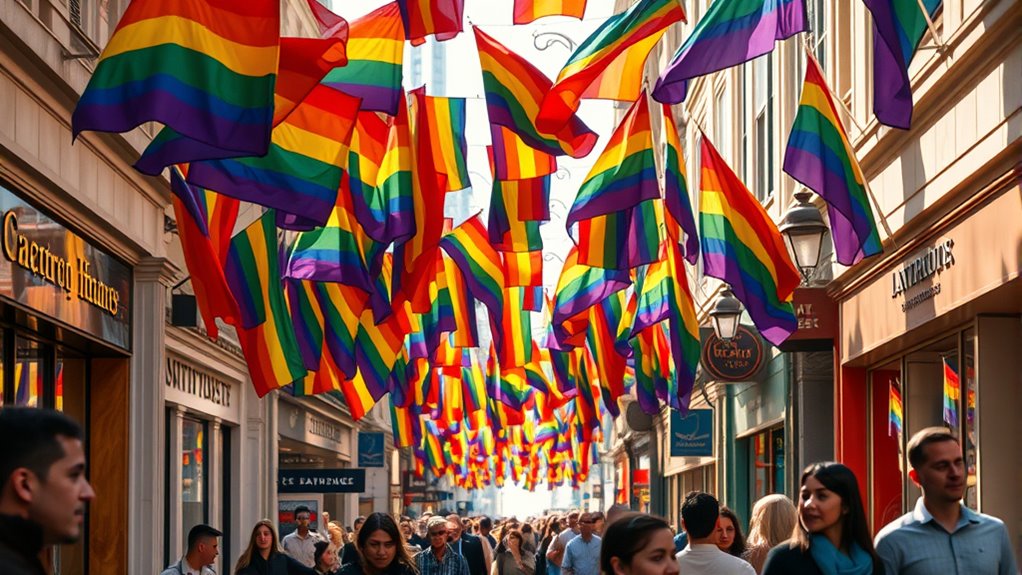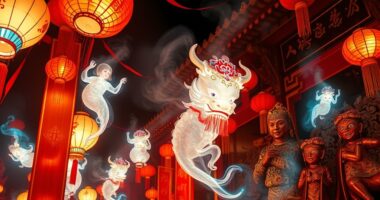The rainbow flag is a vibrant symbol that represents LGBTQ+ pride and cultural identity worldwide. It reflects a history rooted in activism, hope, and unity, connecting diverse communities through shared values of inclusion and resilience. As you see it displayed in marches, murals, or windows, you’re reminded of ongoing struggles and collective progress. Exploring further reveals how this emblem continues to evolve, inspiring new generations and shaping cultural identities around the globe.
Key Takeaways
- Rainbow flags serve as a universal symbol of LGBTQ+ identity and cultural pride worldwide.
- They embody values of diversity, inclusion, hope, and resilience within LGBTQ+ communities.
- The flag’s evolution reflects changing social attitudes and ongoing struggles for equality.
- Displaying the rainbow flag signifies solidarity and recognition of LGBTQ+ rights across cultures.
- It functions as a visual tool to challenge discrimination and promote acceptance in society.

Have you ever wondered why rainbow flags have become powerful symbols of cultural identity? The answer lies in their rich history and the way they’ve evolved to represent more than just colors. Originally, the rainbow flag’s roots can be traced back to the 1970s when Gilbert Baker, an artist and activist, created it as a symbol of hope and unity for the LGBTQ+ community. Its vibrant hues carried deep historical symbolism, each color representing different aspects like life, healing, and spirit. Over time, the rainbow flag grew beyond its initial design, becoming a universal emblem of diversity and inclusion. Its historical symbolism connects generations, reminding people of the ongoing struggle for equality and the importance of embracing differences. As the flag gained prominence, it transformed from a simple marker of identity into a tool of modern activism. Today, it’s waved at marches, hung in windows, and displayed worldwide, serving as a visual rallying cry for rights and recognition. The evolution of the rainbow flag exemplifies how symbols adapt over time, aligning with the changing needs and aspirations of communities. In the sphere of modern activism, the rainbow flag acts as a powerful visual statement that challenges discrimination and promotes acceptance. It’s not just a colorful banner; it’s a call to action, reminding society of the progress made and the work still ahead. When you see a rainbow flag, you’re witnessing more than just a piece of fabric—you’re observing a symbol that carries the weight of history and the energy of contemporary movements. Its presence signals solidarity and a collective demand for equality, making it an essential part of cultural identity for many. The flag’s significance continues to grow as it is embraced by new generations and used in various contexts, from pride parades to social justice campaigns. Its colors serve as a reminder that diversity enriches communities and that everyone deserves respect and dignity. By understanding the historical symbolism behind the rainbow flag, you gain insight into its powerful role in modern activism. It’s a symbol that embodies hope, resilience, and the unwavering fight for human rights. As you observe it flutter in the wind or see it painted on murals, remember that it’s more than just a symbol of LGBTQ+ pride; it’s a testament to the ongoing journey toward a more inclusive and accepting world. The rainbow flag continues to inspire and mobilize people across the globe, making it a essential expression of cultural identity rooted in history and driven by the desire for a better future. Recognizing the flag’s historical symbolism helps deepen understanding of its significance beyond just colors.
Frequently Asked Questions
How Did Rainbow Flags Originate Historically?
Imagine a vibrant tapestry woven from history’s colorful threads—that’s how rainbow flags originated. You learn that their historical origins date back to 1978, when artist Gilbert Baker created the flag as a symbol of pride and diversity. Each color holds symbolic meanings, representing aspects of the LGBTQ+ community. This powerful flag quickly spread, becoming a beacon of hope and unity, illuminating the path toward acceptance worldwide.
Are There Regional Variations in Rainbow Flag Designs?
Yes, there are regional variations in rainbow flag designs, reflecting local cultural symbols and design diversity. You’ll find different colors, patterns, or added symbols that represent unique regional identities and values. These variations help communities express their distinct cultural heritage within the broader rainbow flag symbolism. By incorporating regional symbols, the flags become more personalized, fostering a stronger sense of belonging and highlighting the diversity within the larger cultural movement.
What Are the Challenges in Adopting Rainbow Flags Globally?
You face a tangled web of challenges when adopting rainbow flags globally. Cultural acceptance acts like a delicate glass sculpture—shatter it easily with misunderstandings or prejudice. Political implications add storm clouds, as some nations view the flag as a symbol of rebellion or controversy. Steering through these waters requires sensitivity, diplomacy, and patience, because what’s celebrated in one place might be forbidden or misunderstood in another, making universal acceptance a complex journey.
How Do Rainbow Flags Influence Local Lgbtq+ Policies?
You see that rainbow flags can profoundly influence local LGBTQ+ policies through political activism and cultural symbolism. When you display or support the flag, you raise awareness and foster acceptance, encouraging policymakers to enact inclusive laws. The flag becomes a rallying symbol, uniting communities and amplifying voices that advocate for equal rights, ultimately shaping policies by highlighting the importance of diversity and human rights within local contexts.
Can Rainbow Flags Be Used to Represent Other Cultural Identities?
Yes, rainbow flags can represent other cultural identities through diverse symbolism, showcasing inclusivity and unity. By incorporating specific colors or patterns, you can adapt the rainbow flag to reflect various cultural symbols, traditions, or communities. This use of rainbow flags in cultural symbolism helps you express a broader sense of identity and solidarity, emphasizing that the flag’s vibrant colors can transcend the original LGBTQ+ context to embrace multiple cultural narratives.
Conclusion
As you reflect on the vibrant tapestry of rainbow flags, you realize they gently whisper stories of belonging and pride. These colors, like soft brushstrokes on a cultural canvas, invite you to embrace diversity with warmth and understanding. In their delicate shimmer, they remind you that everyone’s unique hue adds richness to the world’s grand mural. Embrace this harmony, knowing that beneath the spectrum, shared human connection quietly blooms.









